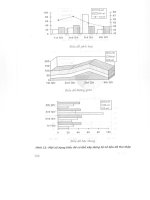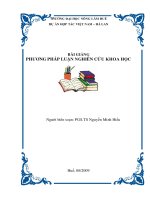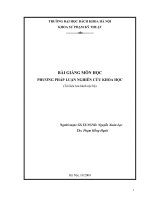31 Phuong phap luan nghien cuu khoa hoc EN05008 DH Mo HN Elearning
Bạn đang xem bản rút gọn của tài liệu. Xem và tải ngay bản đầy đủ của tài liệu tại đây (114.81 KB, 4 trang )
/>
Topic: A study on common English pronunciation mistakes made by HOU (Hanoi Open University)
intermediate gifted English undergraduates in the final English oral test.
Chủ đề: Một nghiên cứu về những sai lầm phát âm tiếng Anh phổ biến do HOU (Đại học Mở Hà Nội) thực
hiện cho sinh viên đại học có trình độ tiếng Anh trung cấp trong bài kiểm tra tiếng Anh cuối cùng.
School: Hanoi Open University
Name: BÙI THỊ THANH ĐAN
Class: FML58
Subject: Research Methodology
Topic: A study on common English pronunciation mistakes
CONTENT
I. Rationale
In order to communicate in a foreign language in the same manner as a native speaker, the learner must
achieve a certain level of accuracy and fluency. Other factors, such as flexibility, tone and size (volume and
length) of speech, are also believed to affect learners' ability to speak (Hedge, 2000). And the fluidity is still
of greatest interest as it appears that these two elements emerge on the upper surface most noticeable to the
communicator. But while the study of language in general and language teaching and learning in particular,
one issue that remains controversial is which of these two factors is more important and more important.
Bipolar trends change over time, but at the present time the trend focuses on message-oriented attention to
fluency rather than accuracy. The concept of accuracy, therefore, is somewhat "forgotten".
Although the current movement does not spend much of the paper on 'accuracy in language' as it deserves,
the notion, clearly expressed in the communicative ability of the communicator, remains closed. an
indispensable role in the process of teaching, learning and mastering a language. This is even more true in
the case of English: one can assess a person's education and social status through his phonetics (McDowall,
2002). This means that if an English learner wants to be able to use the language as a native speaker, and
wants to be academically acclaimed, he or she must improve his or her vocabulary.
However, for learners of English as a foreign language, learning and mastering pronunciation is a major
obstacle because the orthography of the English language is "infamously useless" if one wishes to infer the
pronunciation of a word from the word (Lecumberri & Maidment, 2000). Unlike languages where the
writing system can suggest pronunciation of words to a certain extent, such as Vietnamese, Japanese,
Korean, Russian, or French, the relationship between spelling And the phonetics in English is very loose,
making it difficult for new English learners. This is a great obstacle for first-year students in the Hanoi Open
University, as most students do not have access to phonetics systematically and thoroughly in the
curriculum at school.
In the world, studies on the teaching and learning of phonetics also show similar problems. Fraser (200 1)
points out that good pronunciation gives a lot of benefits to immigrants in Australia (in finding a job,
achieving educational goals, or in other aspects of life). Good phonetics is more important than good
grammar, because no matter how perfect the grammar is, it can be completely obscured by poor
pronunciation. However, according to Silveria (2002), vocal teaching has been lacking in English as a
foreign language for a long time because a classical theory holds that phonetics is not important in teaching.
and learn the language, and the learner can self-earn it during the communication process. Fortunately, that
belief was not as popular as before, and teaching and learning he underwent a major change, so that now
becomes a perfect factor not only the ability to communicate but also discourse building, social linguistics,
and linguistic strategies (Morley, 1994).
Based on the situation above, the research team found that it was necessary to introduce the Pronunciation
into the curricula of students in English and American Studies. At present, there are two main groups of
students being trained in the faculty: students studying in the field of education and students studying in the
field of translation. For the first group, the role of vocabulary learning is extremely important, since these
graduates will be the communicators of the skills and knowledge of English to many other learners. If
students do not grasp this language correctly, it leads to misleading information for many people. As for
students in the translation industry, pronunciation is a key tool in the workplace: if they are able to
pronounce well, they will be able to communicate with each other. It's easier.
Pronunciation is even more important for first-year students, as most of them are youngest in college (about
18 to 19 years old). Many studies have shown that older learners are less likely to have the same
pronunciation as native speakers, although other language elements such as grammar or vocabulary may not
be as different. Native speakers can be referred to here as what the dominant authors stand for. Oyama
(1976), Snow & Hoefnagel-Hohle (1977), Werker et al. (1981) or Kenworthy (1988). Therefore, introducing
students to the right language at the beginning of their undergraduate studies is essential to improving their
language skills as well as improving their teaching and learning programs at the university. learn.
Furthermore, the Speech category must be separated into an advanced course that does not integrate with
other skills to enhance students' sense of subjectivity as well as more test and enrichment. What do you say
and communicate in general? This research is intended to provide a more comprehensive view of phonetics
as well as to create a quality and effective curriculum.
II. Aims of the Study
Considering the need of the subject as described above, this research focuses on the task of reevaluating the
teaching and learning process of mathematics in the first semester of 2017-2018 for the first year students.
Most of the English Language Department, Hanoi Open University. By studying the students' opinions
about science and assessing the difficulties and the results of education in science, the research team will
come up with corresponding solutions to improve the later courses.
III. Research Questions
In general, this study would like to answer the following questions:
What are the strengths and weaknesses of pronunciation?
What is the student's desire for content as well as the form of teaching and learning of pronunciation?
What is the student's overall assessment of the pronunciation course?
IV. Scope of the Study
Due to the limited time, objects, funding sources, facilities and objective limitations of the subject itself, the
implementation of this course is only for First year student of English Faculty.
Research objectives: awareness and importance of pronunciation. Analyze the status of first-year students in
phonics, survey and evaluate the implementation of the course, and develop some methods and
recommendations to improve the quality of teaching and learning phonetics.
V. Methods of Study
The research method used in the study is the case study method based on the object of the vocal instruction.
Research subjects are full-time first-year students of the Faculty of English. The questionnaire was given at
the end of the first year of the 2017 - 2018
Elective Data collection tool investigates the effectiveness of application through feedback
Data collection tools investigated the effectiveness of the application through student feedback on
instrumentation survey methods using the survey questionnaire.
The process of collecting the data after a questionnaire has been given to the student will be collected and
sent to the teaching staff as the teacher for statistics and collection. After that, the main teacher will gather
and analyze the data.
The method of analyzing the resulting quantitative data is quantified in percentages from 0 to 100 and taken
to a number after the comma.
Open Question Sections for students to make comments and contribute to improve the quality of teaching
and learning will be synthesized from the common points of interest.
From the results obtained from the survey and analysis of the data, the authors can accurately assess the
feasibility and effectiveness of the teaching of pronunciation through learners' needs and draw comments
that are directly applicable and contribute suggestions to improve the quality of teaching and learning
pronunciation.
VI. Tentative Design of the Study
Concept of pronunciation
Phonetic research consists of two areas: phonetics and phonology
In phonetics studies the sound of speech. A phonetist usually studies one of the following:
the influence of structure, mind and nerves, to speech (commonly known as the psychological function of
phonetics)
The movement and movement of the organ structure in the process of sound generation, commonly known
as phonetic pronunciation nature and Do Van's sound waves during the sonic process How sound is
identified by the hearing organ How the brain perceives sound Phonetics is a broad field and does not need
to be directly related to language study. Although the phonetic studies mentioned above can be studied
independently of other disciplines, they are completely interrelated. For example, the organ structure
produces sounds, sounds are transmitted in the form of sound waves, sound waves are transmitted to the
auditory organs and processed into the brain.
If the phonetics is related to the physical nature of the speech, he learns to rethink the problem of how to
understand and sound the system. Phonology studies sound systems and vocal components that exist in a
particular language. Phonological studies include the work of English as vowel and consonant, and
transcendental. in the field of phonology When it comes to vowels and consonants it refers to the different
sounds we create when it comes to speech, not the vowels and consonants that we write. would be wrong If
As we would assume that phonology is always monolingual. Many phonetic studies have generalized rules
and organizations and sound representations can be applied for many languages.
VII. Outline of Literature Review
Modern linguistics is developed in two main ways to learn pronunciation. That is the direction of imitation
by intuition and the direction of linguistic analysis :
The method of imitation depends on the ability of the learner to hear and imitate the tone and sound of the
language without the intervention of any interpretation of the information. This approach also implies the
availability of ideal models to apply. the help of the first recorders followed by tape, labs in language and
the mid-twentieth century and nowadays as audio-visual media such as video boards and CDs.
Linguistic analysis uses information and media such as phonetic alphabet, phonetic description, phonetic
system description, comparative comparisons, Ability to listen, imitate, pronounce. This method provides
information directly to the learner and directs the focus to the sound and tone of the language. This method
has been developed to the completion stage rather than the Implications for the Imitation Method
1.
Key concepts
Vowel-consonant distinction: The best method is to use minimal pairing exercises
ex: Circle what you hear :
a / Don't slip / sleep On The Floor.
b / he's gone to back up / pack up the car.
Word Accent: The word accent recognition can be checked by selecting a word or sentence with
accent markings. True in a recorded conversation or text or teacher reads ex: mark the selection
indicating the main stress of the word (from capital = main stress)
Photography is one of my favorite activities.
a/ PHOtography
b/ PhoTOgraphy
c/ PhotoGRAphy
d/ ACtivities.
e/ acTIVities.
f/ activities.
String words that can be identified by the array in the sentence can be made as with the word stress
EX: listen and select appropriate accent:
a/ HI. I'm DAVID. WHAT'S your name?
b/ HI. I'M David. What's YOUR name?
c/ Hi. I'm David. What's your name?
2. Related studies (optional)
-BBC Learning English. Website address : www.bbclearningenglish.com
-Hancock, M.& Donna, S (2007). Pronunciation in use – An intermediate course.
Cambridge: Cambridge University Press
-Pronunciation Power 1, 2
VIII. References Tài liệu tham khảo
-Baker, A. (2001). Ship or sheep- An intermediate course. Cambridge: Cambridge University Press.
-Baker, A. (2006). Tree or three - An elementary pronunciation course. Cambridge: Cambridge University
Press.
-BBC Learning English. Website address : www.bbclearningenglish.com
-English Computerized Learning Inc. Pronuciation Power (Software).
-Lecuberri, M. & Maidment, J. (2000). English transcription course. London: Oxford University Press.









